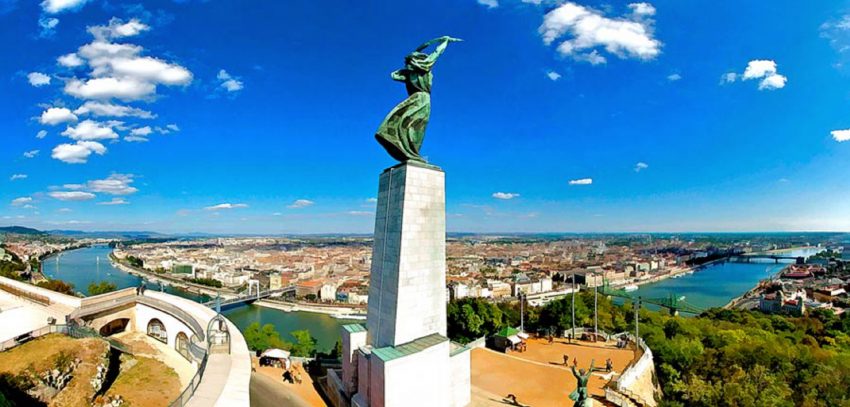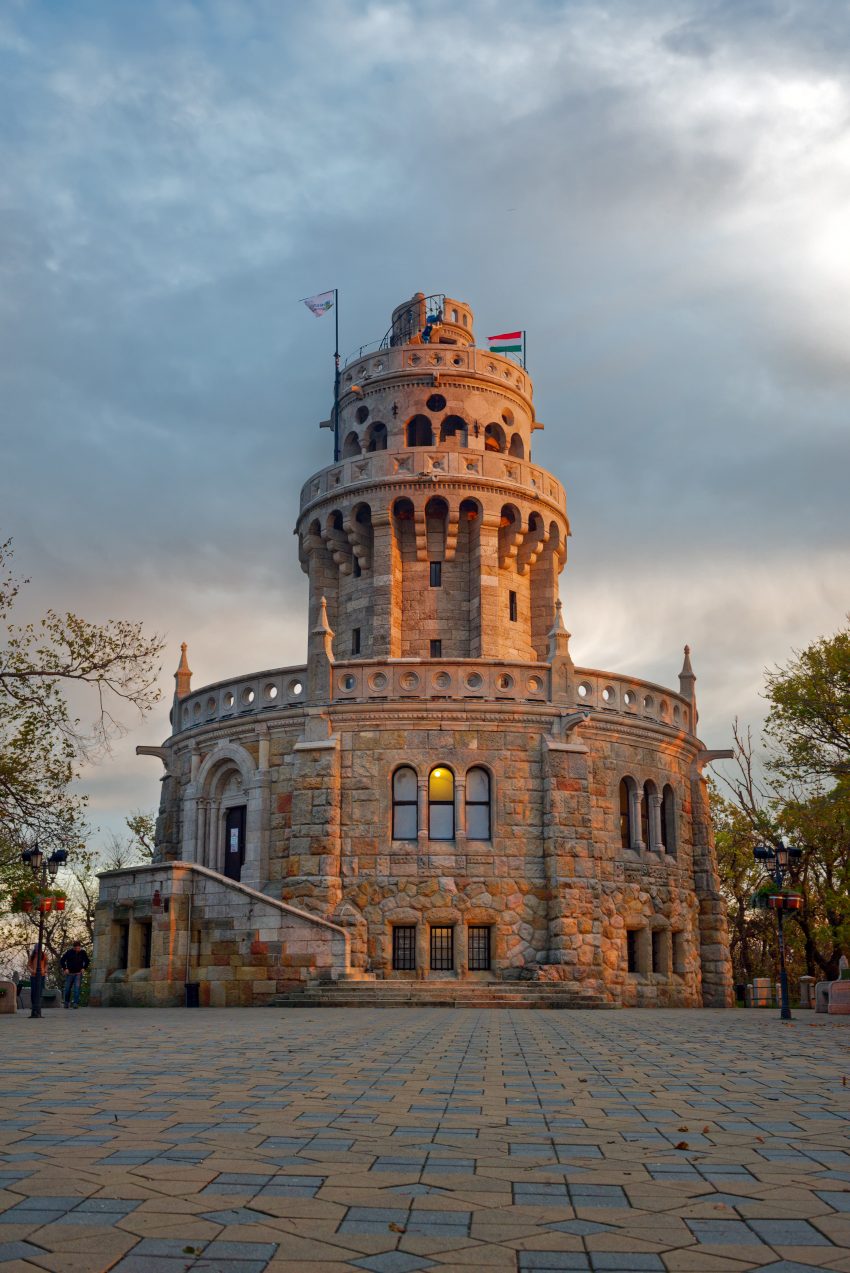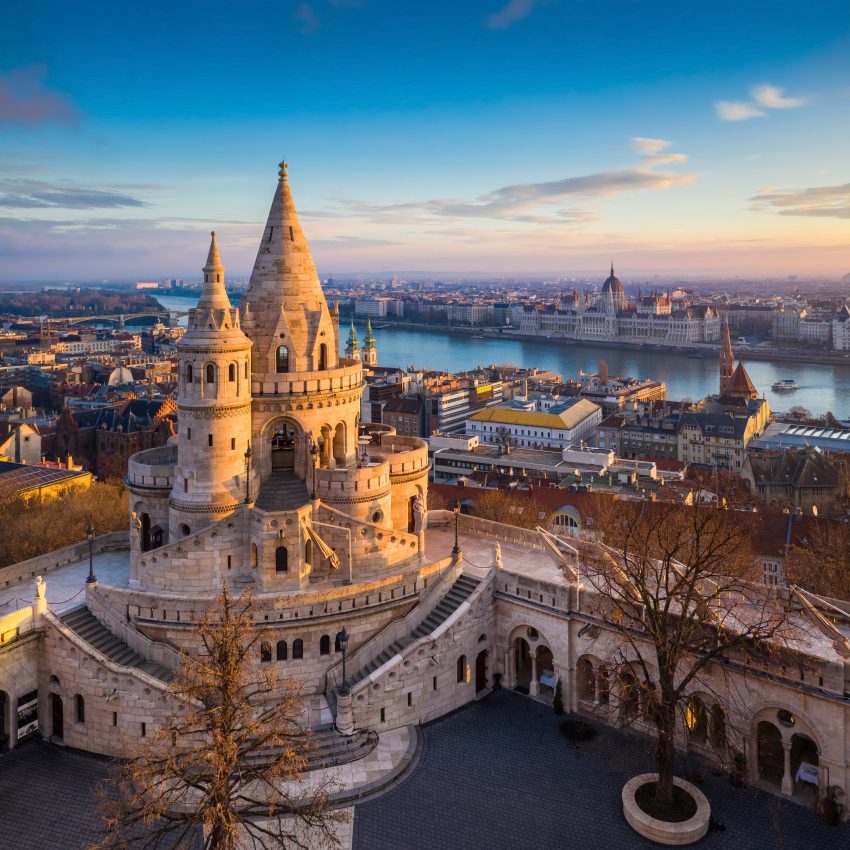Budapest’s skyline may not be dotted with soaring skyscrapers, but it’s still stunning enough to warrant getting someplace high to take in the view in all its glory. Below you’ll find the top spots for a lofty, panoramic experience.
Citadel
Sitting atop Gellért Hill, the Citadel was built on the orders of Julius von Haynau, an Austrian commander who became infamous as the Hangman of Arad, a nickname he received after brutally executing thirteen Hungarian rebel generals in 1849 for their involvement in the failed Hungarian revolution. Finished in 1854 by Hungarian forced labourers, the Citadel lost its military function in 1897, and a few years later its walls were finally demolished. Today, the square in front of the former fortress is visited by thousands of people every day for the gorgeous panoramic view it offers to the Royal Palace, all the Danube bridges of the city, and downtown Pest. In addition, Gellért Hill boasts a number of lesser-known viewpoints, well suited for sharing a bottle of wine with your friends while taking in the vista.

Erzsébet Lookout Tower
Erzsébet Lookout Tower is located atop the 527-metre high János Hill, making it the highest viewing spot in the city. It is named in honour of Empress Elisabeth (fondly known as Sissi in the lands of the former Austro-Hungarian Empire), who visited the area several times in the year 1882. Reachable from Széll Kálmán tér by bus 21A, or from the Zugliget neighbourhood either by taking the chairlift or the world-renowned Children’s Railway, the neo-Romanesque-style lookout was built in 1910 by Frigyes Schulek, the same architect who oversaw the renovation of Matthias Church and the construction of Fisherman’s Bastion. For a long time, the building doubled as a weather station, but now its sole purpose is to provide visitors with a breathtaking panoramic view of Budapest and the tower’s hilly, wooded surroundings.

Fisherman’s Bastion
Built from Kőbánya limestone, this historicizing terrace was designed and built by Frigyes Schulek between 1895 and 1902, as the final leg of the Matthias Church restoration project (which was also carried out by Schulek). Its seven spired towers symbolize the seven chieftains of the conquering Magyar tribes, while its name refers to the medieval fishermen’s guild, who were responsible for defending this section of Buda’s castle wall. Originally, Fisherman’s Bastion would’ve also featured a statue complex of the seven Magyar chieftains, but the plans were changed at the last minute and the statues ended up as part of the Millennium Memorial on Heroes’ Square. The balconies of the fairy-tale structure provide a superb view of the Danube, the Parliament building, and the rest of Castle Hill, free of charge, all year round.

Margaret Island Water Tower
The ferro-cement water tower of picturesque Margaret Island is one of the city’s most eye-catching Art Nouveau structures. Situated in the northern section of the floating park, the 57-metre high industrial monument was built in 1911 following the plans of architect Rezső Vilmos Ray and engineer Szilárd Zielenski. As the tallest water tower in the country, it offers an unparalleled view of other Budapest landmarks from its balconied observation deck. Nowadays, the romantic tower doesn’t hold any water, and instead hosts various art exhibitions throughout the year in the chamber dome.

Gül Baba’s Tomb
As part of its Ottoman heritage, Budapest gives home to Islam’s northernmost holy site: built between 1543 and 1548, Gül Baba’s Tomb is situated at the end of the similarly named steep and romantic cobblestoned street on Rózsa Hill. The octagonal shaped, domed spectacle marks the burial place of a famous Turkish dervish (whose name translates to Father of the Roses) who died during the siege of Buda in 1541. Surrounded by an artistically designed garden and complete with a museum showcasing everyday life in Turkish Buda, the tomb park also offers a magnificent view over the city, which you can enjoy between Tuesday and Sunday from 10 AM to 6 PM.
St. Stephen’s Basilica
Named after the patron saint and first Christian king of Hungary, the impressive St. Stephen’s Basilica is the tallest building in Budapest, together with the Hungarian Parliament, which both peak at 96 metres (a symbolic number referring to the arrival of the Hungarian tribes to Carpathian Basin in 896). To reach the panorama terrace of its central dome (which was destroyed two times, once during construction in 1868, then again in 1947) walk up the stairs (containing 364 steps) or take the elevator, and marvel in the motley medley of inner city rooftops, church spires, and roof ornaments. Entry is 1000 HUF.





